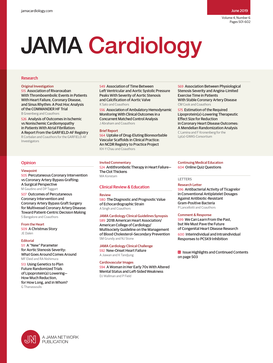人类首次实时mr引导心室消融治疗特发性流出道过早心室复合物。
IF 14.1
1区 医学
Q1 CARDIAC & CARDIOVASCULAR SYSTEMS
引用次数: 0
摘要
导管消融是治疗症状性室性心律失常的基础疗法,但目前的技术依赖于透视和电解剖定位,这只能提供有限的软组织细节,并使患者和工作人员暴露在电离辐射下。实时磁共振(MR)引导消融可以克服这些限制,使心脏解剖、基底和病变形成的直接可视化,所有这些都在无辐射的环境中。目的探讨磁共振实时射频心室消融技术的可行性和安全性。设计、环境和参与者:这是一项正在进行的VISABL-VT非随机临床试验的前瞻性、全球首例入组病例,该试验评估了磁共振引导下射频消融室性心动过速。手术和分析于2025年4月在一个学术三级医疗中心进行,该中心配备了标准的1.5 t MR成像(MRI)套件和专用的MR兼容电生理平台,MR兼容12导联心电图监测和记录系统,MR条件除颤器,以及与MRI扫描仪集成的实时导管跟踪,用于同步成像和消融。患者是一名73岁男性,有症状,药物难治性流出道室性早搏(PVCs)。介入消融在全身麻醉下在MRI扫描仪内进行。术中获得的非对比三维MR血管造影成像用于创建手术的解剖路线图。使用主动跟踪诊断导管和消融导管进行实时导管跟踪和激活定位。制图首先在右室后间隔流出道发现最早的激活,消融短暂地抑制了室性早搏。异位复发,但最终通过左冠状动脉尖逆行主动脉入路消融解决。术后MRI证实病变形成。主要结果和措施:室性早搏抑制及是否存在手术并发症。结果手术在实时MRI引导下完成,无并发症。室性早搏完全抑制,观察30分钟或随访2个月无复发。结论:这是首例人类病例,表明完全在实时MR引导下,心室消融可以安全有效地进行。VISABL-VT试验的进一步证据将阐明临床效用和长期结果。本文章由计算机程序翻译,如有差异,请以英文原文为准。
First-in-Human Real-Time MR-Guided Ventricular Ablation for Idiopathic Outflow Tract Premature Ventricular Complexes.
Importance
Catheter ablation is a cornerstone therapy for symptomatic ventricular arrhythmias, yet current techniques rely on fluoroscopy and electroanatomic mapping, which provide limited soft-tissue detail and expose patients and staff to ionizing radiation. Real-time magnetic resonance (MR)-guided ablation may overcome these limitations by enabling direct visualization of cardiac anatomy, substrate, and lesion formation, all within a radiation-free environment.
Objective
To demonstrate the technical feasibility and safety of the first-in-human real-time MR-guided radiofrequency ventricular ablation procedure.
Design, Setting, and Participant
This was a prospective, worldwide-first roll-in case from the ongoing VISABL-VT nonrandomized clinical trial assessing MR-guided radiofrequency ablation of ventricular tachycardia. The procedure and analysis were performed in April 2025 at an academic tertiary care center equipped with a standard 1.5-T MR imaging (MRI) suite and dedicated MR-compatible electrophysiology platform, MR-compatible 12-lead electrocardiographic monitoring and recording system, MR-conditional defibrillator, and real-time catheter tracking integrated with the MRI scanner for synchronized imaging and ablation. The patient was a 73-year-old man with symptomatic, drug-refractory outflow tract premature ventricular complexes (PVCs).
Intervention
The ablation was performed under general anesthesia inside the MRI scanner. Intraprocedurally acquired noncontrast 3-dimensional MR angiographic imaging was used to create an anatomical roadmap for the procedure. Real-time catheter tracking and activation mapping were performed using actively tracked diagnostic and ablation catheters. Mapping identified earliest activation first in the posterior septal right ventricular outflow tract, where ablation transiently suppressed PVCs. Ectopy recurred but was ultimately resolved by ablation performed via a retrograde aortic approach in the left coronary cusp. Lesion formation was confirmed via postprocedural MRI.
Main Outcomes and Measures
Suppression of PVCs and presence or absence of procedural complications.
Results
The procedure was performed under real-time MRI guidance without complications. PVCs were completely suppressed, with no recurrence during 30-minute observation or at 2-month follow-up.
Conclusions
This first-in-human case demonstrates that ventricular ablation can be safely and effectively performed entirely under real-time MR guidance. Further evidence from the VISABL-VT trial will clarify clinical utility and long-term outcomes.
求助全文
通过发布文献求助,成功后即可免费获取论文全文。
去求助
来源期刊

JAMA cardiology
Medicine-Cardiology and Cardiovascular Medicine
CiteScore
45.80
自引率
1.70%
发文量
264
期刊介绍:
JAMA Cardiology, an international peer-reviewed journal, serves as the premier publication for clinical investigators, clinicians, and trainees in cardiovascular medicine worldwide. As a member of the JAMA Network, it aligns with a consortium of peer-reviewed general medical and specialty publications.
Published online weekly, every Wednesday, and in 12 print/online issues annually, JAMA Cardiology attracts over 4.3 million annual article views and downloads. Research articles become freely accessible online 12 months post-publication without any author fees. Moreover, the online version is readily accessible to institutions in developing countries through the World Health Organization's HINARI program.
Positioned at the intersection of clinical investigation, actionable clinical science, and clinical practice, JAMA Cardiology prioritizes traditional and evolving cardiovascular medicine, alongside evidence-based health policy. It places particular emphasis on health equity, especially when grounded in original science, as a top editorial priority.
 求助内容:
求助内容: 应助结果提醒方式:
应助结果提醒方式:


